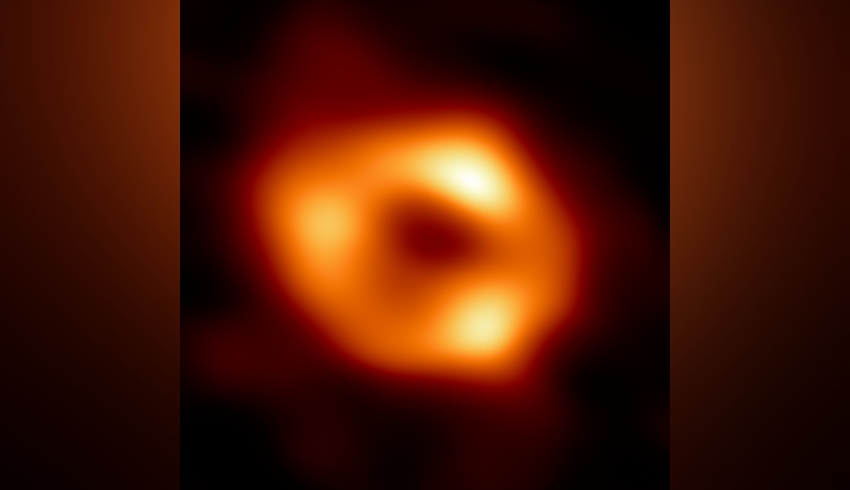Announced on Thursday, the global research team behind the Event Horizon Telescope (EHT) organisation said that this image provides “overwhelming evidence” that the closely studied object is in fact a black hole.
The supermassive black hole pictured is called Sagittarius A* (pronounced A-star), and sits about 27,000 light years away from Earth, and has a mass equal to around four million suns.
“We were stunned by how well the size of the ring agreed with predictions from Einstein’s Theory of General Relativity,” said EHT Project scientist Geoffrey Bower from the Institute of Astronomy and Astrophysics, Academia Sinica, Taipei.
“These unprecedented observations have greatly improved our understanding of what happens at the very centre of our galaxy and offer new insights on how these giant black holes interact with their surroundings.”
A black hole is a section in space where gravity pulls extraordinarily tight that not even light can escape the force, and this is because of matter. While these objects don’t take up space, they have a lot of matter that has been squeezed into an extremely tiny area, as a result of the death of a star.
These beasts are often seen by the glowing gases at the edge of its “event horizon”, which is the boundary of where the rate needed to escape the hole exceeds the speed of light, meaning matter and radiation can fall in, but cannot get out.
Astronomers had previously seen stars orbiting around something invisible, compact and huge at the centre of the Milky Way, now this image provides “direct visual evidence” that it is a black hole.
The news comes about three years after the same telescope collaboration captured the first image of a supermassive black hole in 2019, dubbed M87*, which resides at the centre of the more distant Messier 87 galaxy.

It weighs around 6.5 billion times the mass of the sun and is located roughly 55 million light years away from Earth, much larger than the Sgr A*.
To capture the smaller supermassive black hole, the EHT linked together eight existing radio telescopes across the planet to form one single Earth sized one, also known as a technique called “very long baseline interferometry”.
While the two black holes are extremely similar, researchers had to develop new tools to account for the gas movement around Sgr A*.
“We have two completely different types of galaxies and two very different black hole masses, but close to the edge of these black holes they look amazingly similar,” says Sera Markoff, co-chair of the EHT Science Council and a professor of theoretical astrophysics at the University of Amsterdam.
“This tells us that general relativity governs these objects up close, and any differences we see further away must be due to differences in the material that surrounds the black holes.”
To detect black holes, astronomers typically have to see the affect they are having on objects close by, such as a star being torn apart as it gets drawn in by its incessant gravitational tides.
But detecting Sgr A* took a lot more work.
According to Space.com, the Earth’s atmosphere which is “water-laden” can absorb the submillimetre radio waves that the EHT can capture. Therefore, the gas and dust between Sgr A* and Earth can “scatter” the waves and make the image blurry, which made the latest discovery much more difficult.
Despite M87 being further away, the black hole is consuming extraordinary loads of gas, meaning it is far brighter. Therefore, the EHT is able to detect the light, in the form of radio waves, from the hot gas spinning around the edge of its event horizon.
But less material from surrounding objects, such as comets and stars, are being ripped into Sgr A*.
Harvard astrophysicist Michael Johnson said that Sgr A* is being starved, as the telescope could only see a “trickle of material” falling into the black hole, which has remained a mystery for many years.
“In human terms, it would be like eating just one grain of rice every million years.”
Despite this, the researchers were able to reveal the image of Sgr A* by an average of different images extracted from the global team.
While this black hole is more of a mystery, scientists are excited to now be able to compare and contrast the two objects and gain a further understanding of these unseen beasts.
“Now we can study the differences between these two supermassive black holes to gain valuable new clues about how this important process works,” said EHT scientist Keiichi Asada from the Institute of Astronomy and Astrophysics, Academia Sinica, Taipei.
“We have images for two black holes – one at the large end and one at the small end of supermassive black holes in the universe – so we can go a lot further in testing how gravity behaves in these extreme environments than ever before.”
According to the EHT organisation, the astronomers have already begun using the data to test new theories of how gas behaves around supermassive black holes, which may provide a glimpse of the formation and evolution of galaxies.

Isabella Richards
Bella Richards is a journalist who has written for several local newspapers, her university newspaper and a tech magazine, and completed her Bachelor of Communications (Journalism) at the University of Technology Sydney in 2020. She joined Momentum Media in 2021, and has since written breaking news stories across Space Connect, Australian Aviation and World of Aviation.
You can email Bella on: [email protected]

